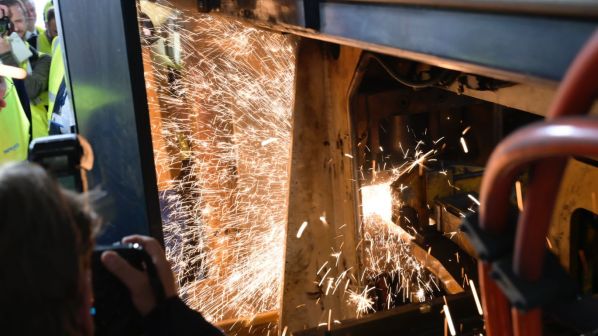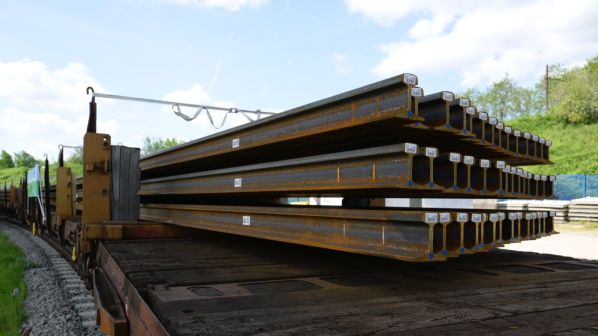THE delivery of new steel rail to Belgian infrastructure manager Infrabel’s rail welding depot north of Brussels in June was met with the pomp and ceremony expected at the unveiling of any ground-breaking new technology. The event was attended by the Belgian federal minister for mobility, Mr Georges Gilkinet, as well as Infrabel CEO, Mr Benoît Gilson, and Dr Karl-Ulrich Köhler, the former chairman of the board of management of Saarstahl, the company that manufactured the rail.
But what was most remarkable about the rail is just how unremarkable it looks, and that’s the point: while the steel it was made from was produced using the electric arc furnace method, the rail is manufactured to exactly the same standard and specification as that produced through the blast furnace process, albeit with a carbon footprint 70% lower than traditional rail.
A 480m-long train carried 900 tonnes of rail, the first to be delivered under a €200m contract Infrabel awarded to Saarstahl Rail at the end of 2022. Saarstahl Rail will deliver up to 2800km of green rail over the next four years, reducing emissions by around 224,000 tonnes. The rail is delivered in 100m-long sections that will then be welded at the Haren depot into 300m-long sections ready to be installed on the Belgian rail network.
“We are talking to all those railways and metros to help them to understand what green rail is. Obviously, we can show them evidence and data that we are really reducing the CO₂ impact.”
Dominique Chiesura
The choice of green rail by Infrabel follows a trend gaining traction around the world.
“The trend started in France, although now you can see that many railways in Europe are pushing for green rail usage,” explains Saarstahl Rail commercial director, Mr Dominique Chiesura. This includes interest from Denmark and Sweden, as well as discussions with railways such as German Rail (DB) and interest from further afield such as Indian Railways (IR).
“We can see that the trend is there, and the demand will be there soon,” he says. “We are talking to all those railways and metros to help them to understand what green rail is. Obviously, we can show them evidence and data that we are really reducing the CO₂ impact.”
The use of electric arc furnaces is not new. The process was popularised in the United States, but blast furnaces are still predominantly used in the European steel sector. European specifications already allow for the use of steel produced in an electric arc furnace, meaning Saarstahl Rail was only required to undertake some certification with the customer to allow the installation of the new rail on the network. But the slow rate of introduction can be attributed more to attitudes within the sector and requirements within the infrastructure managers ordering the rail.

“The rail business, and also the steel business, are very conservative,” explains Saarstahl Rail plant manager, Dr Nadine Artelt. “That means if you would like to see a change in that business, it takes time.”
Saarstahl Rail’s parent company, the German-based Stahl-Holding-Saar (SHS), entered the electric arc sector in 2021, when the company completed the takeover of Liberty Steel’s Ascoval plant and the Hayange rail unit in northern France. The Hayange and Saint-Saulve steelworks were subsequently renamed as Saarstahl Rail and Saarstahl Ascoval, respectively.
French National Railways (SNCF) had already been interested in using rail made from steel produced at the Ascoval steel mill using the electric arc method, following pressure from the French government and the European Union to reduce emissions, and this process was explored on a larger scale with SHS.
Production method
In the traditional steelmaking process, iron ore and coke are heated in a blast furnace, the steel produced is then placed in a converter where the final chemical composition is adjusted, often through the addition of scrap metal or worn rail.
In the electric arc furnace method, only scrap metal or worn rail is used. “You dip the electrodes in the scrap, and you melt it by heating up this mixture,” Chiesura says. “You have some development of CO₂ but it is very small compared with a blast furnace.
“We tend to use a lot of worn rail that we can get from our customers. We have some supplies of rail from Infrabel and the main portion will come from SNCF… so we are implementing a circular economy where we take the worn rail from SNCF, we melt them to produce the blooms, the blooms are converted into rails, and then the rails are sold back to SNCF.”
“We must produce very high-quality rail because we are transporting passengers at 330km/h on these rails, even though they are produced from scrap, so we are very careful with the quality.”
Dominique Chiesura
This cyclic process has a theoretical limit, as residuals are introduced each time the rail is recycled, but this will take years to build up, Artelt says. For this, the steel sector has also developed the direct reduction installation (DRI) system to process iron ore using hydrogen instead of coal, massively reducing emissions.
While electric arc furnaces are energy intensive, France’s low-carbon energy mix limits the level of CO₂ produced. Around 70-75% of France’s energy is produced from nuclear power, with another 15-20% coming from renewable sources.
In December 2022, SHS together with its subsidiaries Saarstahl and Dillinger Hütte, and the Montan-Stiftung-Saar foundation announced a €3.5bn investment in the production of green steel in Germany’s Saarland region. This includes the installation of new electric arc furnaces at the Völklingen and Dillingen sites, along with the installation of a DRI system at the latter.
Rail properties
The chemical composition of rail made of steel produced by the electric arc process is the same as that produced in a blast furnace. This ensures that it can be used in exactly the same way as traditional rail, meaning the welding and maintenance process can remain the same.
“They conducted some welding tests to be sure that they could use the rail in the same manner as before, but we have not heard of any problems with the electric arc furnace rails compared with the blast furnace rails, there are no differences,” Artelt says. “The specification has tolerances, and we are inside these.”
The cost difference between blast furnace and electric arc-produced steel is dependent on a number of variable factors, which can determine which is costlier to produce. This includes the difference in price between gas and electricity, which have both been affected in different ways following Russia’s invasion of Ukraine. The rising cost of iron ore and coking coal has also negatively impacted the cost of producing steel in a blast furnace while seasonal variations in the cost of electricity is another factor. “It’s a balance,” Chiesura says. “Sometimes we are higher, sometimes we are lower.”
The tightening of a carbon tax in France is expected to balance the cost between the two manufacturing methods. Manufacturers currently pay €260 in tax for the 2.6 tonnes of CO₂ produced during the manufacture of 1 tonne of steel.
“In the future, we believe that this tax will increase even more so the difference will definitely be there,” Chiesura says.
Infrabel says the tender for the contract won by Saarstahl Rail did not specifically call for the supply of green rail but that Saarstahl Rail’s bid was still the most competitive, showing that it is already a cost-effective alternative.
Another challenge to the introduction of green rail, however, is the requirement for public bodies to go to open tender, which cannot favour one company over another.
“The main issue we have today is that we are the leader in this field… but in public international tenders they must keep some kind of competition between all the suppliers,” Chiesura says. “And for them, it’s difficult to push for a product that is manufactured only by one producer.”
This is beginning to change as new tenders are starting to include a favourable weighting in the evaluation for bidders that can demonstrate CO₂ reduction. Tendering for the Grand Paris Express metro project, for example, has included requirements for contractors to demonstrate how they are reducing CO₂ in both the materials they are sourcing and the way they are working, such as by using electrically-powered construction machinery.
“The two main products in the railway that are high-impact are steel and concrete,” Chiesura says. “So they have to demonstrate that the concrete sleepers and all steel material have a low CO₂ impact.”
Overall, though, the same safety requirements that underpin the rail sector are also paramount for manufacturers of steel rail.
“We must produce very high-quality rail because we are transporting passengers at 330km/h on these rails, even though they are produced from scrap,” Chiesura says. “So we are very careful with the quality.”

